-
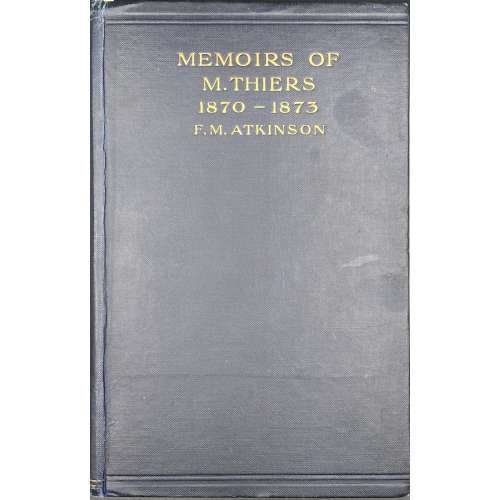 Title: MEMOIRS OF M. THIERS | 1870—1873 | Translated by | F. M. ATKINSON | {publisher’s device} | LONDON: GEORGE ALLEN & UNWIN LTD. | RUSKIN HOUSE 40 MUSEUM STREET, W.C. Pagination: [6] 7-384. Collation: 8vo; [1]-248. Size: 23 x 15 cm Binding: Blue cloth, top and bottom ruled in blind, gilt lettering to front cover and spine. Original: Adolphe Thiers. Notes et souvenirs de M. Thiers, 1870-1873: voyage diplomatique, proposition d'un armistice, préliminaires de la paix, présidence de la République. — Paris : [s.n.], 1901. — 465 p. The preface and editing signed "F. D." [Félicie Dosne]. Félicie Dosne (French, 1823 – 1906) was Thiers's sister-in-law.
Title: MEMOIRS OF M. THIERS | 1870—1873 | Translated by | F. M. ATKINSON | {publisher’s device} | LONDON: GEORGE ALLEN & UNWIN LTD. | RUSKIN HOUSE 40 MUSEUM STREET, W.C. Pagination: [6] 7-384. Collation: 8vo; [1]-248. Size: 23 x 15 cm Binding: Blue cloth, top and bottom ruled in blind, gilt lettering to front cover and spine. Original: Adolphe Thiers. Notes et souvenirs de M. Thiers, 1870-1873: voyage diplomatique, proposition d'un armistice, préliminaires de la paix, présidence de la République. — Paris : [s.n.], 1901. — 465 p. The preface and editing signed "F. D." [Félicie Dosne]. Félicie Dosne (French, 1823 – 1906) was Thiers's sister-in-law. -
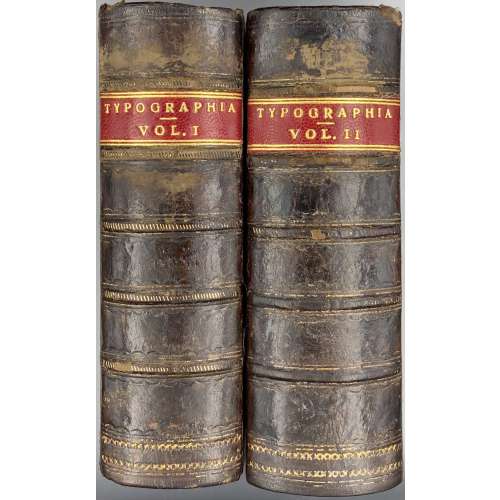 2 volume set. Vol. 1. Title: Typographia, | OR THE | Printers' Instructor : | INCLUDING AN ACCOUNT | of the | ORIGIN OF PRINTING, | with | Biographical Notices of the Printers of | England, from Caxton to the close | of the Sixteenth Century : | A Series of | Ancient and Modern Alphabets, | and | DOMESDAY CHARACTERS : | Together with | An Elucidation of every Subject con- | nected with the Art. | By J. JOHNSON, Printer. |{stanza}| Vol. I. | In frame: Published by Messrs. Longman, Hurst, | Rees, Orme, Brown & Green, Pater- | noster Row, London | Under the frame: 1824. || Typographical frame with the names of distinguished printers; on the cornerstone: William Caxton, 1474. Pagination: ffl / blank, blank / engraved frontis., engraved t.p. / blank, engraved dedication / list of club members, engraved arms vignette / blank, [4] pedigree, [i] ii-xii – preface, [1] 2-610, [10] – index, bfl. Text printed in the frame. To ffl : previous owner’s inscription: Herbert Heath | from | William Blades. | Xmas 1886; Frontispiece: Portrait of John Johnson at age 46, engraved on wood by W. Hughes; t.p.: TYPOGRAPHIA, | OR THE | PRINTERS INSTRUCTOR | BY | J.JOHNSON | PRINTER. VOL. 2. | 1824 | frame with lettering, top: GUTTnbg – FAUST – ELZEVIR – ALDUS, bottom: MENTZ – STRASbg –HARLAEM | below: BIBLIOTHECA • BODLEIANA. | below the frame: G.W.BONNER SC ||; Dedication to Earl Spenser, K. G., and the members of The Roxburghe Club, dated 1824, engraved on wood by W. Hughes; Arms vignette: Roxburghe Club | Instituted | June XVII | M D CCCXII || engraved on wood by William Harvey. Provenance: Admiral Sir Herbert Leopold Heath, KCB MVO (1861 – 1954); William Blades (1824 – 1890) – English printer and bibliographies. Inscription to ffl in both vols:D. Bateman. Vol. 2. Pagination: ffl, t.p. (similar lettering, but Vol. II.) / blank, [2] advert., [i] ii-iv contents, [1, 2] 3-663 [664] [16]. Points: Vol. 1.: Frontispiece portrait of Caxton replaced by a portrait of J. Johnson from Vol. 2, engraved t.p. of Vol. 1. replaced by t.p. of Vol. 2; Vol. 2 without engraved t.p., and without frontispiece. Edition: First Edition. Size: 16mo. 12.5 x 8.5 cm Binding: Mid-nineteenth century polished calf, the covers with a border of a gilt double fillet and blind roll. Spine divided into six panels with raised bands flanked with gilt fillets, lettered on new red goatskin labels, marbled endleaves and edges. Seller's description:
2 volume set. Vol. 1. Title: Typographia, | OR THE | Printers' Instructor : | INCLUDING AN ACCOUNT | of the | ORIGIN OF PRINTING, | with | Biographical Notices of the Printers of | England, from Caxton to the close | of the Sixteenth Century : | A Series of | Ancient and Modern Alphabets, | and | DOMESDAY CHARACTERS : | Together with | An Elucidation of every Subject con- | nected with the Art. | By J. JOHNSON, Printer. |{stanza}| Vol. I. | In frame: Published by Messrs. Longman, Hurst, | Rees, Orme, Brown & Green, Pater- | noster Row, London | Under the frame: 1824. || Typographical frame with the names of distinguished printers; on the cornerstone: William Caxton, 1474. Pagination: ffl / blank, blank / engraved frontis., engraved t.p. / blank, engraved dedication / list of club members, engraved arms vignette / blank, [4] pedigree, [i] ii-xii – preface, [1] 2-610, [10] – index, bfl. Text printed in the frame. To ffl : previous owner’s inscription: Herbert Heath | from | William Blades. | Xmas 1886; Frontispiece: Portrait of John Johnson at age 46, engraved on wood by W. Hughes; t.p.: TYPOGRAPHIA, | OR THE | PRINTERS INSTRUCTOR | BY | J.JOHNSON | PRINTER. VOL. 2. | 1824 | frame with lettering, top: GUTTnbg – FAUST – ELZEVIR – ALDUS, bottom: MENTZ – STRASbg –HARLAEM | below: BIBLIOTHECA • BODLEIANA. | below the frame: G.W.BONNER SC ||; Dedication to Earl Spenser, K. G., and the members of The Roxburghe Club, dated 1824, engraved on wood by W. Hughes; Arms vignette: Roxburghe Club | Instituted | June XVII | M D CCCXII || engraved on wood by William Harvey. Provenance: Admiral Sir Herbert Leopold Heath, KCB MVO (1861 – 1954); William Blades (1824 – 1890) – English printer and bibliographies. Inscription to ffl in both vols:D. Bateman. Vol. 2. Pagination: ffl, t.p. (similar lettering, but Vol. II.) / blank, [2] advert., [i] ii-iv contents, [1, 2] 3-663 [664] [16]. Points: Vol. 1.: Frontispiece portrait of Caxton replaced by a portrait of J. Johnson from Vol. 2, engraved t.p. of Vol. 1. replaced by t.p. of Vol. 2; Vol. 2 without engraved t.p., and without frontispiece. Edition: First Edition. Size: 16mo. 12.5 x 8.5 cm Binding: Mid-nineteenth century polished calf, the covers with a border of a gilt double fillet and blind roll. Spine divided into six panels with raised bands flanked with gilt fillets, lettered on new red goatskin labels, marbled endleaves and edges. Seller's description:John Johnson (1777-1848) operated Sir Samuel Egerton Brydges's Lee Priory Press before a falling-out. Typographia was printed at his Apollo Press, in Brook Street, Holborn, with the financial support of Edward Walmsley, and came out in four sizes. "Of the few standard works on the art of printing in the English language, this is perhaps the most familiar. [The first volume contains] a table of the introduction of the art into the different countries, after which comes the "introduction and art in Great Britain", with a list of the productions of the first printers up to 1599. The second volume may be described as practical, in contradistinction to the first, which is historical. It gives a description of types, directions for composing, for press, and warehouse work, &c. It is particularly rich in foreign alphabets, a feature which has gained of it great estimation. It has long since become, and deservedly, a printer's classic" - Bigmore & Wyman, I, pp.371-2.
Note: This is the book that served as a source of plagiarism for Adams's Typographia: a brief sketch of the origin, rise, and progress of the typographic art published in Philadelphia by himself in 1837. The copy returned to the seller for the reason stated in section Points above and replaced with the unaltered copy LIB-2693.2021. -
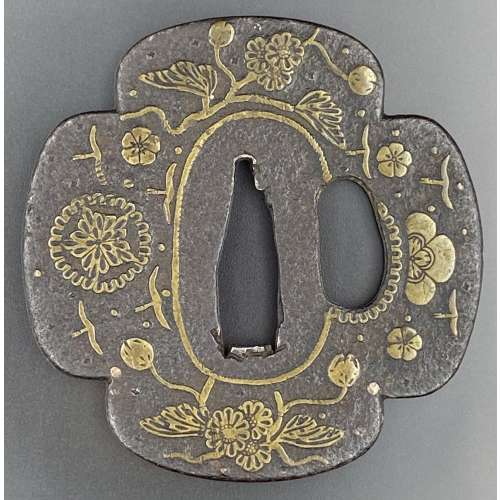 Iron tsuba of quatrefoil form (mokka-gata) adorned with the design of stars, wild geese, blossoms, leaves and tendrils realized in the brass inlay. The inlay technique includes suemon-zōgan and ten-zōgan. A smaller opening (kozuka hitsu-ana) surrounded by a scalloped brass border. The seppa-dai bordered with linear inlay. A few dots of inlay on both sides are missing. Measurements: height 71 mm, width 70 mm, thickness at centre 2.7 cm Time: Late Muromachi (1514 – 1573)
Iron tsuba of quatrefoil form (mokka-gata) adorned with the design of stars, wild geese, blossoms, leaves and tendrils realized in the brass inlay. The inlay technique includes suemon-zōgan and ten-zōgan. A smaller opening (kozuka hitsu-ana) surrounded by a scalloped brass border. The seppa-dai bordered with linear inlay. A few dots of inlay on both sides are missing. Measurements: height 71 mm, width 70 mm, thickness at centre 2.7 cm Time: Late Muromachi (1514 – 1573) -
![Maurice Joly. Les affamés. Études de mœurs contemporaines. — Paris, E. Dentu, 1876. — pp.: [1 half-title, verso colophone] [1 title, verso blank] [i] ii-xvi, 1-340.](https://varshavskycollection.com/wp-content/uploads/2021/02/LIB-1038.2016-a-500x500.jpeg) Title page: MAURICE JOLY | LES | AFFAMÉS | ÉTUDES | DE MŒURS CONTEMPORAINES |{publisher’s device «ED»}| PARIS | E. DENTU, LIBRAIRE-ÉDITEUR | PALAIS-ROYAL, 15-17-19, GALERIE D’ORLÉANS | 1876 | Tous droits réservés.|| Pagination: short ffl, [2] h.t. / colophon [2] t.p. / blank] [i] ii-xvi, 1-340. Collation: 12mo ; π10 1-1812 198. Binding: 19 x 12 cm; softcover; original wrappers with lettering to front and spine in black and red in a frame, untrimmed lateral edge.
Title page: MAURICE JOLY | LES | AFFAMÉS | ÉTUDES | DE MŒURS CONTEMPORAINES |{publisher’s device «ED»}| PARIS | E. DENTU, LIBRAIRE-ÉDITEUR | PALAIS-ROYAL, 15-17-19, GALERIE D’ORLÉANS | 1876 | Tous droits réservés.|| Pagination: short ffl, [2] h.t. / colophon [2] t.p. / blank] [i] ii-xvi, 1-340. Collation: 12mo ; π10 1-1812 198. Binding: 19 x 12 cm; softcover; original wrappers with lettering to front and spine in black and red in a frame, untrimmed lateral edge. -
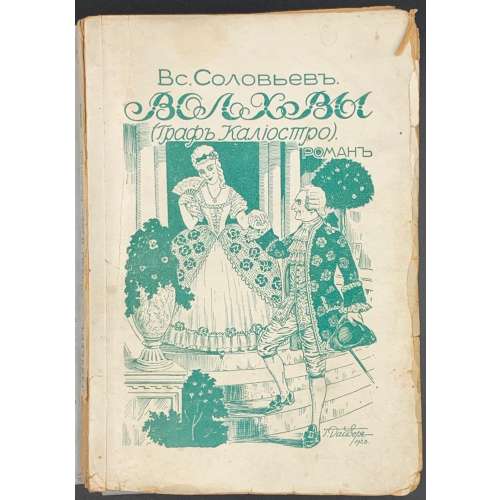 Title: ВСЕВОЛОДЪ СОЛОВЬЕВЪ | ВОЛХВЫ | (Граф Калиостро) | РОМАНЪ |[…]| ИЗДАНIЕ М. ДИДКОВСКАГО | Рига, Ткацкая 9 || Pagination: [1-2] 3-187 [188 blank], [4] advert., in original pictorial wrappers by Г. Дайберъ [Heinrich Deiber]. Size: 21 x 15 cm Allegedly, vol. 1st of 2 vol. edition.
Title: ВСЕВОЛОДЪ СОЛОВЬЕВЪ | ВОЛХВЫ | (Граф Калиостро) | РОМАНЪ |[…]| ИЗДАНIЕ М. ДИДКОВСКАГО | Рига, Ткацкая 9 || Pagination: [1-2] 3-187 [188 blank], [4] advert., in original pictorial wrappers by Г. Дайберъ [Heinrich Deiber]. Size: 21 x 15 cm Allegedly, vol. 1st of 2 vol. edition. -
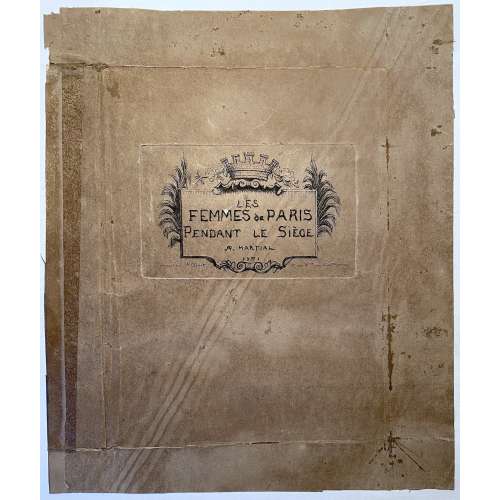 A suite of 12 etchings 160 x 118 mm each, in the first state, pasted on paper, 2 per sheet, with a cover (250 x 210 mm).0. Cover. Les femmes de Paris pendant le siège./R.Martial/1871.1. Lorsqu'à l'approche de l'ennemi on demandait l'éloignement des bouches inutiles [...] 2. L'Ennemi ! 3. No inscription 4. Quête pour les veuves. 5. Concert et quête pour les enfants blessés, malades, infirmes. 6. Au bastion/Et celles non moins précieuses qui dirigeaient ces ventes [...] 7. Vente pour les orphelins de la guerre. 8. No inscription 9. Une ration, bouillie romaine et Vin/Cantine municipale[...] 10. No inscription 11. No inscription 12. Les effets de cette union patriotique des femmes sont connus.[...]
A suite of 12 etchings 160 x 118 mm each, in the first state, pasted on paper, 2 per sheet, with a cover (250 x 210 mm).0. Cover. Les femmes de Paris pendant le siège./R.Martial/1871.1. Lorsqu'à l'approche de l'ennemi on demandait l'éloignement des bouches inutiles [...] 2. L'Ennemi ! 3. No inscription 4. Quête pour les veuves. 5. Concert et quête pour les enfants blessés, malades, infirmes. 6. Au bastion/Et celles non moins précieuses qui dirigeaient ces ventes [...] 7. Vente pour les orphelins de la guerre. 8. No inscription 9. Une ration, bouillie romaine et Vin/Cantine municipale[...] 10. No inscription 11. No inscription 12. Les effets de cette union patriotique des femmes sont connus.[...] -
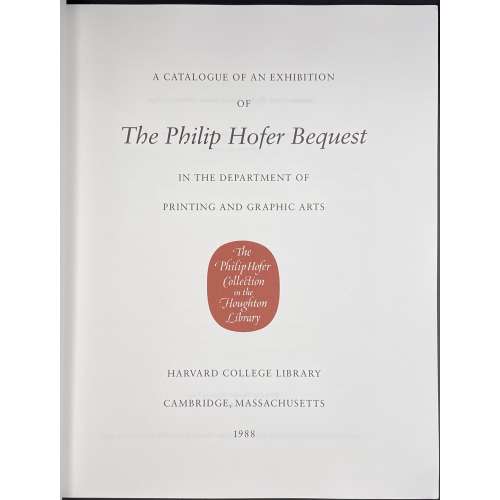 A CATALOGUE OF AN EXHIBITION | OF | The Philip Hofer Bequest | IN THE DEPARTMENT OF | PRINTING AND GRAPHIC ARTS | {white in crimson cartouche The | Philip Hofer | Collection | in the | Houghton | Library} | HARVARD COLLEGE LIBRARY | CAMBRIDGE, MASSACHUSETTS | 1988 || Printed by Meriden-Stinehour Press; Roderick Douglas [Rocky] Stinehour (American, 1925 – 2016) and his son Stephen Stinehour, The Stinehour Press in Lunenburg, Vermont. The Meriden Gravure Company in Meriden, Connecticut, was founded in 1888 by Charles Parker and James F. Allen. In 1977, the Meriden merged with the Stinehour Press, and in 1989, the Meriden operations were closed and the Meriden Gravure presses moved to the Vermont location. Pagination: [i-vi] – incl. h.t., t.p., f.t., vii-xiv, [1] 2-218, 100 plates, within pagination, incl. bibliography, index. Binding: Original grey paper wrappers with title printed in red and white.
A CATALOGUE OF AN EXHIBITION | OF | The Philip Hofer Bequest | IN THE DEPARTMENT OF | PRINTING AND GRAPHIC ARTS | {white in crimson cartouche The | Philip Hofer | Collection | in the | Houghton | Library} | HARVARD COLLEGE LIBRARY | CAMBRIDGE, MASSACHUSETTS | 1988 || Printed by Meriden-Stinehour Press; Roderick Douglas [Rocky] Stinehour (American, 1925 – 2016) and his son Stephen Stinehour, The Stinehour Press in Lunenburg, Vermont. The Meriden Gravure Company in Meriden, Connecticut, was founded in 1888 by Charles Parker and James F. Allen. In 1977, the Meriden merged with the Stinehour Press, and in 1989, the Meriden operations were closed and the Meriden Gravure presses moved to the Vermont location. Pagination: [i-vi] – incl. h.t., t.p., f.t., vii-xiv, [1] 2-218, 100 plates, within pagination, incl. bibliography, index. Binding: Original grey paper wrappers with title printed in red and white. -
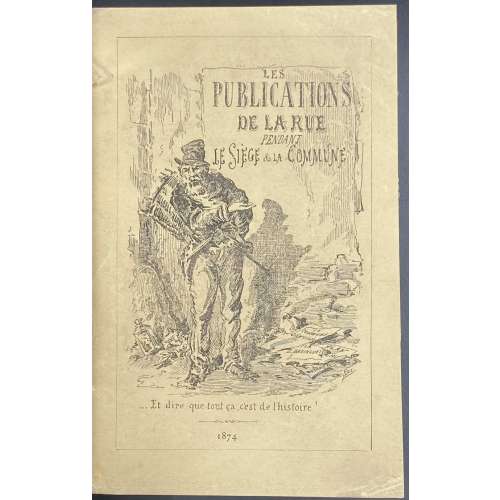 Convolute with three editions, dedicated to the Commune of Paris, 1871. (1) LES | Publications de la Rue | pendant | LE SIEGE ET LA COMMUNE | SATIRES — CANARDS — COMPLAINTES — CHANSONS | PLACARDS ET PAMPHLETS | BIBLIOGRAPHIE | PITTORESQUE ET ANECDOTIQUE | Par Firmin MAILLARD |{publisher’s device}| PARIS | AUGUSTE AUBRY, ÉDITEUR | 18, RUE SÉGUIER, 18 | 1874 || Pagination: ffl, original pictorial wrapper, [2] – blank / advert., [2] – h.t. / blank, [2] – h.t. / colophon imprim. PILLET FILS AINÉ, frontis. similar to front wrapper without '1874', [2] – t.p. / blank, [v] vi-xii, [1] 2-198, three blank leaves, back wrapper. (2) VILLE DE SAINT-DENIS | EXPOSITION D'ART & D'HISTOIRE | La Commune de Paris |18 Mars 1871 28 Mai | AVANT-PROPOS DE Lucien DESCAVES | de l’Académie Goncourt | PREFACE DE Jacques DORIOT | Député de la Seine, Maire de Saint-Denis | Du 17 Mars au 26 Mai 1935 | au Musée Municipal | 4, place de la Légion d’Honneur – Saint-Denis || Pagination: original pictorial wrapper in black and red, frontis., [2] - t.p. / blank, [2] – commité, v-xiii [xiv] 1-113 [114], 26 plates (13 leaves), blank back wrapper, spine tipped-in. (3) J. LEMONNYER | LES | JOURNAUX DE PARIS | PENDANT | LA COMMUNE | REVUE BIBLIOGRAPHIQUE COMPLETE | DE LA PRESSE PARISIENNE | du 19 Mars au 27 Mai | AVEC |{7 lines of text}| ET | UNE TABLE ALPHABÉTIQUE | DONNANT LE PRIX-COURANT DE CHAQUE COLLECTION | PARIS : J. LEMONNYER, Librarire | 73, Rue de Provence, 73 || Pagination: [2] - t.p. / blank, [2] – preface, [7] 8-94, green back wrapper w/advert., bfl. (lacks original front wrapper). Binding: Modern (20th century) red cloth, black label with gilt lettering to spine, matching marbled endpapers. Size: 18.5 x 13 cm; 12mo.
Convolute with three editions, dedicated to the Commune of Paris, 1871. (1) LES | Publications de la Rue | pendant | LE SIEGE ET LA COMMUNE | SATIRES — CANARDS — COMPLAINTES — CHANSONS | PLACARDS ET PAMPHLETS | BIBLIOGRAPHIE | PITTORESQUE ET ANECDOTIQUE | Par Firmin MAILLARD |{publisher’s device}| PARIS | AUGUSTE AUBRY, ÉDITEUR | 18, RUE SÉGUIER, 18 | 1874 || Pagination: ffl, original pictorial wrapper, [2] – blank / advert., [2] – h.t. / blank, [2] – h.t. / colophon imprim. PILLET FILS AINÉ, frontis. similar to front wrapper without '1874', [2] – t.p. / blank, [v] vi-xii, [1] 2-198, three blank leaves, back wrapper. (2) VILLE DE SAINT-DENIS | EXPOSITION D'ART & D'HISTOIRE | La Commune de Paris |18 Mars 1871 28 Mai | AVANT-PROPOS DE Lucien DESCAVES | de l’Académie Goncourt | PREFACE DE Jacques DORIOT | Député de la Seine, Maire de Saint-Denis | Du 17 Mars au 26 Mai 1935 | au Musée Municipal | 4, place de la Légion d’Honneur – Saint-Denis || Pagination: original pictorial wrapper in black and red, frontis., [2] - t.p. / blank, [2] – commité, v-xiii [xiv] 1-113 [114], 26 plates (13 leaves), blank back wrapper, spine tipped-in. (3) J. LEMONNYER | LES | JOURNAUX DE PARIS | PENDANT | LA COMMUNE | REVUE BIBLIOGRAPHIQUE COMPLETE | DE LA PRESSE PARISIENNE | du 19 Mars au 27 Mai | AVEC |{7 lines of text}| ET | UNE TABLE ALPHABÉTIQUE | DONNANT LE PRIX-COURANT DE CHAQUE COLLECTION | PARIS : J. LEMONNYER, Librarire | 73, Rue de Provence, 73 || Pagination: [2] - t.p. / blank, [2] – preface, [7] 8-94, green back wrapper w/advert., bfl. (lacks original front wrapper). Binding: Modern (20th century) red cloth, black label with gilt lettering to spine, matching marbled endpapers. Size: 18.5 x 13 cm; 12mo. -
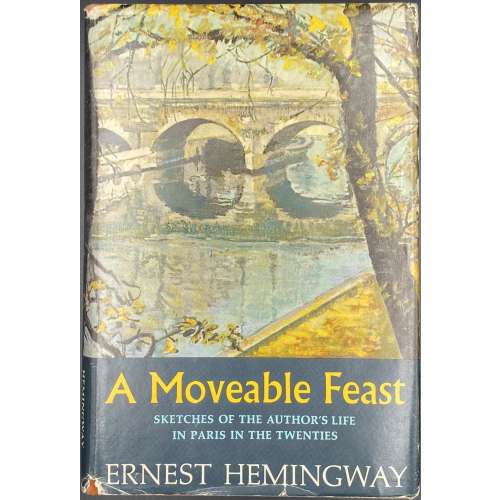 ERNEST HEMINGWAY | A Moveable Feast | {Citation} | CHARLES SCRIBNER'S SONS, | New York || Pagination: [12] – incl: advert., h.t., t.p., colophon, contents, preface, and note, [1, 2] - f.t. / blank, 3-211 [212]. Publisher’s cloth-backed stamped boards, original dust jacket. Ref.: Hanneman A31a.
ERNEST HEMINGWAY | A Moveable Feast | {Citation} | CHARLES SCRIBNER'S SONS, | New York || Pagination: [12] – incl: advert., h.t., t.p., colophon, contents, preface, and note, [1, 2] - f.t. / blank, 3-211 [212]. Publisher’s cloth-backed stamped boards, original dust jacket. Ref.: Hanneman A31a. -
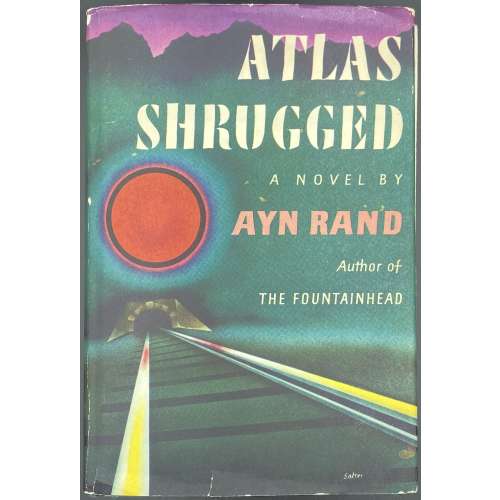 ATLAS | SHRUGGED | AYN RAND | {Publisher's device} | RANDOM HOUSE | NEW YORK || Pagination: [2] - h.t. / advert., [2] – t.p. / colophon, [2] – dedication / blank, [2] – contents / cont., [1, 2] ¬ f.t. / blank, [3] 4-1168 [1169] blank, [1170/71] about the author [1172] blank, two blank leaves. Original green cloth with gilt lettering, black label with gilt lettering and publisher device to spine; top margin green, lateral margin untrimmed. Stated first edition, first printing. Original dust jacket with $6.95 printed price and 10/57 code present on the front flap.
ATLAS | SHRUGGED | AYN RAND | {Publisher's device} | RANDOM HOUSE | NEW YORK || Pagination: [2] - h.t. / advert., [2] – t.p. / colophon, [2] – dedication / blank, [2] – contents / cont., [1, 2] ¬ f.t. / blank, [3] 4-1168 [1169] blank, [1170/71] about the author [1172] blank, two blank leaves. Original green cloth with gilt lettering, black label with gilt lettering and publisher device to spine; top margin green, lateral margin untrimmed. Stated first edition, first printing. Original dust jacket with $6.95 printed price and 10/57 code present on the front flap. -
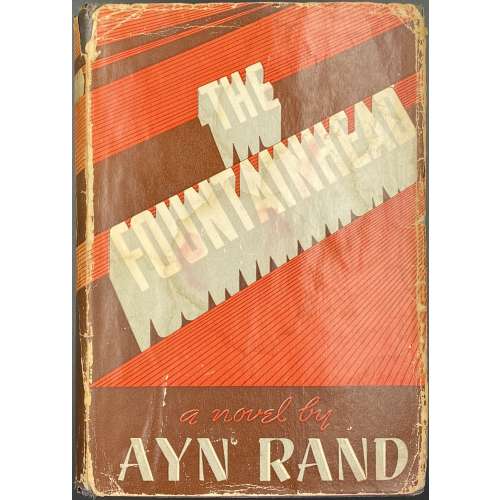 Description: Publisher’s blue cloth lettered in gilt to front cover and spine, spine darkened and rubbed at ends, upper joint starting, pictorial dust jacket with Ain Rand photograph portrait on the back, unclipped ($3,00). Title-page: The | FOUNTAINHEAD | By AYN RAND | THE BOBBS–MERRILL COMPANY, INC. | Publishers | INDIANAPOLIS {space} NEW YORK || Pagination: [1-6] 9-753 [754]. Edition: First edition, later printing; lacks "First edition" statement; blue cloth; photo on the back of DJ, p. 321 line 5 "referred", p. 480 "Domininque" twice.
Description: Publisher’s blue cloth lettered in gilt to front cover and spine, spine darkened and rubbed at ends, upper joint starting, pictorial dust jacket with Ain Rand photograph portrait on the back, unclipped ($3,00). Title-page: The | FOUNTAINHEAD | By AYN RAND | THE BOBBS–MERRILL COMPANY, INC. | Publishers | INDIANAPOLIS {space} NEW YORK || Pagination: [1-6] 9-753 [754]. Edition: First edition, later printing; lacks "First edition" statement; blue cloth; photo on the back of DJ, p. 321 line 5 "referred", p. 480 "Domininque" twice. -
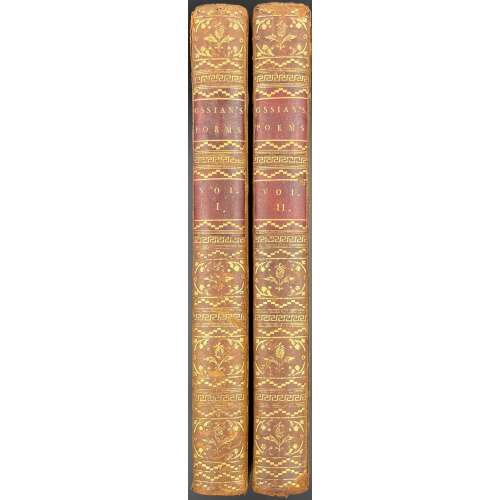 Vol. 1: THE | POEMS | OF | OSSIAN. | TRANSLATED | By JAMES MACPHERSON, Esq; | IN TWO VOLUMES. VOL. I. | A NEW EDITION. | LONDON: | PRINTED FOR W. STRAHAN ; AND T. CADELL, | IN THE STRAND. | M DCC XC.|| Pagination: 2 blank leaves, [2] - t.p. / blank, [v] vi-xiv, [2] - contents / cont., [1, 2] 3-404, one blank leaf. Collation: 8vo; π1 A-Z8 Aa-Cc8 Dd2 Vol. 2: THE | POEMS | OF | OSSIAN. | TRANSLATED | By JAMES MACPHERSON, Esq; | VOL. II. | A NEW EDITION. | LONDON: | PRINTED FOR W. STRAHAN ; AND T. CADELL, | IN THE STRAND. |M DCC XC.|| Pagination: 2 blank leaves, [2] - t.p. / blank, [2] - contents / blank, [1, 2] 3-436, [2] advert. / advert., two blank leaves. Collation: 8vo; π4 B-Z8 Aa-Ee8 Ff2 A1. Two volumes, 21.5 x 14 cm; hardcover; full tree calf gilt-tooled with stylized meander ruled boards inside and outside, flat spite tooled in gilt with meander and pineapples in compartments, two crimson lettered labels. margins speckled blue; peacock marbled endpapers, owner's karks to front pastedown: Owen J. Williams sticker and H. A. Lonis armorial bookplate with an earl's crown, hand-written inscription H. A. and H. C. Williams Wynn and ink stamp of Arthur J. Frank. James Macpherson (British, 1736–1796) was a Scottish writer, poet, literary collector and politician, known as the "translator" of the Ossian cycle of epic poems. Publishing Year: 1790 Publisher: W. Strahan and T. Cadell
Vol. 1: THE | POEMS | OF | OSSIAN. | TRANSLATED | By JAMES MACPHERSON, Esq; | IN TWO VOLUMES. VOL. I. | A NEW EDITION. | LONDON: | PRINTED FOR W. STRAHAN ; AND T. CADELL, | IN THE STRAND. | M DCC XC.|| Pagination: 2 blank leaves, [2] - t.p. / blank, [v] vi-xiv, [2] - contents / cont., [1, 2] 3-404, one blank leaf. Collation: 8vo; π1 A-Z8 Aa-Cc8 Dd2 Vol. 2: THE | POEMS | OF | OSSIAN. | TRANSLATED | By JAMES MACPHERSON, Esq; | VOL. II. | A NEW EDITION. | LONDON: | PRINTED FOR W. STRAHAN ; AND T. CADELL, | IN THE STRAND. |M DCC XC.|| Pagination: 2 blank leaves, [2] - t.p. / blank, [2] - contents / blank, [1, 2] 3-436, [2] advert. / advert., two blank leaves. Collation: 8vo; π4 B-Z8 Aa-Ee8 Ff2 A1. Two volumes, 21.5 x 14 cm; hardcover; full tree calf gilt-tooled with stylized meander ruled boards inside and outside, flat spite tooled in gilt with meander and pineapples in compartments, two crimson lettered labels. margins speckled blue; peacock marbled endpapers, owner's karks to front pastedown: Owen J. Williams sticker and H. A. Lonis armorial bookplate with an earl's crown, hand-written inscription H. A. and H. C. Williams Wynn and ink stamp of Arthur J. Frank. James Macpherson (British, 1736–1796) was a Scottish writer, poet, literary collector and politician, known as the "translator" of the Ossian cycle of epic poems. Publishing Year: 1790 Publisher: W. Strahan and T. Cadell -
![[James Macpherson]. The Poems of Ossian / Translated by James Macpherson, Esq; In Two Volumes. A New Edition; Two volume set. — London: Printed for W. Strahan and T. Cadell, MDCCLXXXIV [1784]. — Vol.1: [i-v] vi-xiii, [2] 3-404 pp; vol.2: [6], [2] 3-435 pp.](https://varshavskycollection.com/wp-content/uploads/2021/02/LIB-2397.2020-500x500.jpeg) Vol. 1: THE | POEMS | OF | OSSIAN. | TRANSLATED | By JAMES MACPHERSON, Esq; | IN TWO VOLUMES. VOL. I. | A NEW EDITION. | LONDON: | PRINTED FOR W. STRAHAN ; AND T. CADELL, | IN THE STRAND. | MDCCLXXXIV.|| Vol. 2:THE | POEMS | OF | OSSIAN. | TRANSLATED | By JAMES MACPHERSON, Esq; | VOL. II. | A NEW EDITION. | LONDON: | PRINTED FOR W. STRAHAN ; AND T. CADELL, | IN THE STRAND. | MDCCLXXXV.|| Vol.1: [i-v] vi-xiii, [2] 3-404 pp; vol.2: [6], [2] 3-435 pp. Two volumes, 22.5 x 14.7 cm; hardcover; full calf with the spines later professionally rebound; original boards with sympathetic repairs to the margins and corners.5 raised bands, red label with gilt lettering to Sp. Bindings remain firm, page blocks firm, boards stained, pages a little rippled, with occasional marks throughout. spotting and marks to endpapers. James Macpherson (British, 1736–1796) was a Scottish writer, poet, literary collector and politician, known as the "translator" of the Ossian cycle of epic poems. Publishing Year: 1784 Publisher: W. Strahan and T. Cadell
Vol. 1: THE | POEMS | OF | OSSIAN. | TRANSLATED | By JAMES MACPHERSON, Esq; | IN TWO VOLUMES. VOL. I. | A NEW EDITION. | LONDON: | PRINTED FOR W. STRAHAN ; AND T. CADELL, | IN THE STRAND. | MDCCLXXXIV.|| Vol. 2:THE | POEMS | OF | OSSIAN. | TRANSLATED | By JAMES MACPHERSON, Esq; | VOL. II. | A NEW EDITION. | LONDON: | PRINTED FOR W. STRAHAN ; AND T. CADELL, | IN THE STRAND. | MDCCLXXXV.|| Vol.1: [i-v] vi-xiii, [2] 3-404 pp; vol.2: [6], [2] 3-435 pp. Two volumes, 22.5 x 14.7 cm; hardcover; full calf with the spines later professionally rebound; original boards with sympathetic repairs to the margins and corners.5 raised bands, red label with gilt lettering to Sp. Bindings remain firm, page blocks firm, boards stained, pages a little rippled, with occasional marks throughout. spotting and marks to endpapers. James Macpherson (British, 1736–1796) was a Scottish writer, poet, literary collector and politician, known as the "translator" of the Ossian cycle of epic poems. Publishing Year: 1784 Publisher: W. Strahan and T. Cadell -
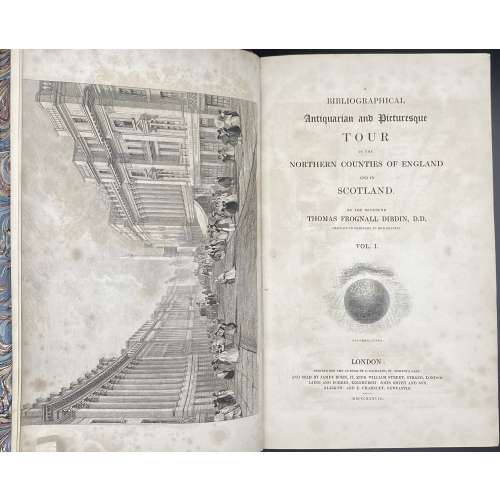 Vol. 1: A | BIBLIOGRAPHICAL | Antiquarian and Picturesque | TOUR | IN THE | NORTHERN COUNTIES OF ENGLAND | AND IN | SCOTLAND. | BY THE REVEREND | THOMAS FROGNALL DIBDIN, D.D. | CHAPLAIN IN ORDINARY TO HER MAJESTY. | VOL. I. |{device} motto: DEI OMNIA PLENA | LONDON: | PRINTED FOR THE AUTHOR BY C. RICHARDS, ST. MARTIN’S LANE : | AND SOLD BY JAMES BOHN, 12 KING WILLIAM STREET, STRAND, LONDON : | LAING AND FORBES, EDINBURGH : JOHN SMITH AND SON, | GLASGOW : AND E. CHARNLEY, NEWCASTLE. | MDCCCXXXVIII.|| Pagination: ffl, frontispiece by W. Douglas after T. M. Richardson, [i-ii] t.p. / blank; [iii-iv] - dedication to Frances Mary Richardson Currer (British, 1785 – 1861) / blank, [v] vi-xv – preface, [i] ii-xxx – supplement & index, [2] – corrections / colophon, [2] list of plates, [2] – contents, [1] 2-436, bfl; 11 plates extraneous to collation (incl. frontis.), lacking one plate (facing p. 213. “Thos. Bridges…”), in-text woodcut vignettes, head- and tailpieces. Collation: 8vo; π8 a-b8 [c2] B-Z8 2A-2E8 2F2. Vol. 2: Similar title but "VOL. II." Pagination: ffl, frontispiece portrait of Hugh Stewart, Aged 84 by Robert Bell after Alison (nothing known); [2] – t.p. / blank, [2] – contents / cont., [437-8] f.t. / blank [439] 440-1090, bfl; 453/4 misprinted 449/50; lacking list of subscribers. Collation: 8vo; π2 [2F3-2F6] 2G-2Z8 3A-3Z8. Binding: By J. Leighton, Brewer Street. Later half dark brown morocco over marbled boards, raised bands with gilt fillets, gilt titling and fillets in compartments, all edges gilt, marbled endpapers. Edition: 1st edition of Dibdin’s last major work and the only edition of this title. Size: 24.5 x 15.5 cm Provenance: Lord Ronald Gower (British, 1845 – 1916); Frank Hird (British, 1873 – 1937). Catalogue raisonné: Jackson 89; Windle & Pippin A65, pp. 179–188 [LIB-2669.2021]. Artists: Abraham, [I.] Frederic Henry (British, 1790 – 1845) Carmichael, James John Wilson (British, 1800 – 1868) Geikie, Walter (British, 1795 – 1837) Harraden, Richard Bankes (British, 1778 – 1862) Hill, David Octavius (British, 1802 –1870) McLea, John Watson (British, fl.1832-1861) Nixon, James Henry (British, b. c. 1808) Reynolds, Sir Joshua (British, 1723 – 1792) Richardson, Thomas Miles (British, 1784 – 1848) Scott, J. (British, fl. 19th c.) Wilkinson, T. M. (British, fl. 19th c.) Engravers: Aikman, Alison [spouse of George Aikman?] (British, 1788 – 1865) Bell, Robert Charles (British, 1806 – 1872) Byfield, Mary (British, 1794/5 – 1871) Douglas, William (British, 1780 – 1832) Harraden, F. (British, fl. 1838) Horsburgh, John (British, 1791 –1869) Johnstone, John (British, fl. 1835 – ) Leith & Smith, Lithogrs (Edinburgh) Lizars, William Home (British, 1788 – 1859) Miller, William (British, 1796 – 1882) Penny, William (British, fl. 19th c.) Prior, Thomas Abiel (British, 1809 – 1886) Robinson, H. (British, fl. 19th c.) Smith, Charles John (British, 1803 – 1838) Thomson, James (British, 1788 – 1850)
Vol. 1: A | BIBLIOGRAPHICAL | Antiquarian and Picturesque | TOUR | IN THE | NORTHERN COUNTIES OF ENGLAND | AND IN | SCOTLAND. | BY THE REVEREND | THOMAS FROGNALL DIBDIN, D.D. | CHAPLAIN IN ORDINARY TO HER MAJESTY. | VOL. I. |{device} motto: DEI OMNIA PLENA | LONDON: | PRINTED FOR THE AUTHOR BY C. RICHARDS, ST. MARTIN’S LANE : | AND SOLD BY JAMES BOHN, 12 KING WILLIAM STREET, STRAND, LONDON : | LAING AND FORBES, EDINBURGH : JOHN SMITH AND SON, | GLASGOW : AND E. CHARNLEY, NEWCASTLE. | MDCCCXXXVIII.|| Pagination: ffl, frontispiece by W. Douglas after T. M. Richardson, [i-ii] t.p. / blank; [iii-iv] - dedication to Frances Mary Richardson Currer (British, 1785 – 1861) / blank, [v] vi-xv – preface, [i] ii-xxx – supplement & index, [2] – corrections / colophon, [2] list of plates, [2] – contents, [1] 2-436, bfl; 11 plates extraneous to collation (incl. frontis.), lacking one plate (facing p. 213. “Thos. Bridges…”), in-text woodcut vignettes, head- and tailpieces. Collation: 8vo; π8 a-b8 [c2] B-Z8 2A-2E8 2F2. Vol. 2: Similar title but "VOL. II." Pagination: ffl, frontispiece portrait of Hugh Stewart, Aged 84 by Robert Bell after Alison (nothing known); [2] – t.p. / blank, [2] – contents / cont., [437-8] f.t. / blank [439] 440-1090, bfl; 453/4 misprinted 449/50; lacking list of subscribers. Collation: 8vo; π2 [2F3-2F6] 2G-2Z8 3A-3Z8. Binding: By J. Leighton, Brewer Street. Later half dark brown morocco over marbled boards, raised bands with gilt fillets, gilt titling and fillets in compartments, all edges gilt, marbled endpapers. Edition: 1st edition of Dibdin’s last major work and the only edition of this title. Size: 24.5 x 15.5 cm Provenance: Lord Ronald Gower (British, 1845 – 1916); Frank Hird (British, 1873 – 1937). Catalogue raisonné: Jackson 89; Windle & Pippin A65, pp. 179–188 [LIB-2669.2021]. Artists: Abraham, [I.] Frederic Henry (British, 1790 – 1845) Carmichael, James John Wilson (British, 1800 – 1868) Geikie, Walter (British, 1795 – 1837) Harraden, Richard Bankes (British, 1778 – 1862) Hill, David Octavius (British, 1802 –1870) McLea, John Watson (British, fl.1832-1861) Nixon, James Henry (British, b. c. 1808) Reynolds, Sir Joshua (British, 1723 – 1792) Richardson, Thomas Miles (British, 1784 – 1848) Scott, J. (British, fl. 19th c.) Wilkinson, T. M. (British, fl. 19th c.) Engravers: Aikman, Alison [spouse of George Aikman?] (British, 1788 – 1865) Bell, Robert Charles (British, 1806 – 1872) Byfield, Mary (British, 1794/5 – 1871) Douglas, William (British, 1780 – 1832) Harraden, F. (British, fl. 1838) Horsburgh, John (British, 1791 –1869) Johnstone, John (British, fl. 1835 – ) Leith & Smith, Lithogrs (Edinburgh) Lizars, William Home (British, 1788 – 1859) Miller, William (British, 1796 – 1882) Penny, William (British, fl. 19th c.) Prior, Thomas Abiel (British, 1809 – 1886) Robinson, H. (British, fl. 19th c.) Smith, Charles John (British, 1803 – 1838) Thomson, James (British, 1788 – 1850) -
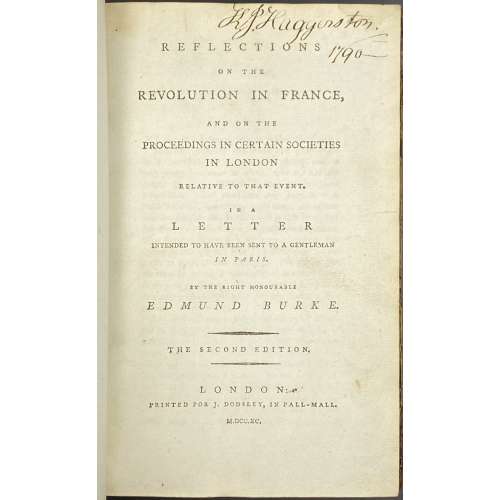 Title: REFLECTIONS | ON THE | REVOLUTION IN FRANCE, | AND ON THE | PROCEEDINGS IN CERTAIN SOCIETIES | IN LONDON | RELATIVE TO THAT EVENT. | IN A | LETTER | INTENDED TO HAVE BEEN SENT TO A GENTLEMAN | IN PARIS. | BY THE RIGHT HONOURABLE | EDMUND BURKE. | — | {in lozenges} THE SECOND EDITION. | —| LONDON: | PRINTED FOR J. DODSLEY, IN PALL-MALL. | M.DCC.XC. || Pagination: [4 blanks] [i-iii] iv, 1-356 [4 blanks]. Collation: 8vo; π2 B-Z8, Aa2. Binding: Quarter calf with marbled boards, gilt fillets, red label with gilt lettering to spine. "King John Haggerston, 1790" handwritten ink inscription to front endpaper, t.p. and p. iii. Seems like Sir John Haggerston, 9th Baronet.
Title: REFLECTIONS | ON THE | REVOLUTION IN FRANCE, | AND ON THE | PROCEEDINGS IN CERTAIN SOCIETIES | IN LONDON | RELATIVE TO THAT EVENT. | IN A | LETTER | INTENDED TO HAVE BEEN SENT TO A GENTLEMAN | IN PARIS. | BY THE RIGHT HONOURABLE | EDMUND BURKE. | — | {in lozenges} THE SECOND EDITION. | —| LONDON: | PRINTED FOR J. DODSLEY, IN PALL-MALL. | M.DCC.XC. || Pagination: [4 blanks] [i-iii] iv, 1-356 [4 blanks]. Collation: 8vo; π2 B-Z8, Aa2. Binding: Quarter calf with marbled boards, gilt fillets, red label with gilt lettering to spine. "King John Haggerston, 1790" handwritten ink inscription to front endpaper, t.p. and p. iii. Seems like Sir John Haggerston, 9th Baronet. -
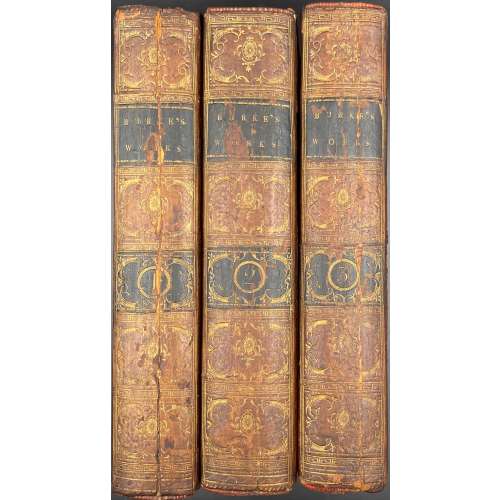 Vol. 1: THE | WORKS | OF THE | RIGHT HONOURABLE | EDMUND BURKE, | COLLECTED IN THREE VOLUMES. | VOL. I. | DUBLIN: | PRINTED FOR R. CROSS, W. WILSON, P. WO-| GAN, L. WHITE, P. BYRNE, A. GRUEBER, J. MOORE, | W. JONES, W. M’KENZIE, H. WATTS, J. RICE, | AND G. FOLINGSBY. | 1792.|| Pagination: 2 blank leaves, [2] - t.p. /blank, [2] - contents / blank, [2] - f.t. / blank, [3] 4-61 [62] - blank, [2] - f.t / blank, [4] contents, 65-580, 1 blank leaf. Collation: 8vo; π2 B-Z8 Aa-Oo8 Pp4. Vol. 2: THE | WORKS | OF THE | RIGHT HONOURABLE | EDMUND BURKE, | COLLECTED IN THREE VOLUMES. | VOL. II. | DUBLIN: | Printed by William Porter, | For R. Cross, W. Wilson, P. Wogan, L. White, P. Byrne, W. M’kenzie, J. Moore, A. Grueber, W. Jones, H. Watts, J. Rice, And G. Folingsby. | M.DCC.XCIII.|| Pagination: 2 blank leaves, [2] - t.p. /blank, [2] - contents / cont., [2] - f.t. / blank, [3] 4-655 [656 blank], 2 blank leaves. Collation: 8vo; π2 B-Z8 Aa-Tt8. Vol. 3: THE | WORKS | OF THE | RIGHT HONOURABLE | EDMUND BURKE, | COLLECTED IN THREE VOLUMES. | VOL. III. | DUBLIN: | PRINTED FOR R. CROSS, W. WILSON, P. WO-| GAN, L. WHITE, P. BYRNE, A. GRUEBER, J. MOORE, | W. JONES, W. M’KENZIE, H. WATTS, J. RICE, | AND G. FOLINGSBY. | 1792.|| Pagination: 2 blank leaves, [2] - t.p. /blank, [2] - contents / blank, [2] - f.t. / blank, 3-602, 3 blank leaves. Collation: 8vo; A-Z8 Aa-Pp8. Binding: Full contemporary calf ruled in gilt, leather spine labels gilt, gilt scrollwork in compartments framed in Greek–key rolls, marbled endpapers, hinges cracked, central vertical split to spine panel to vol. 1 and 3, early ownership signature to titles.
Vol. 1: THE | WORKS | OF THE | RIGHT HONOURABLE | EDMUND BURKE, | COLLECTED IN THREE VOLUMES. | VOL. I. | DUBLIN: | PRINTED FOR R. CROSS, W. WILSON, P. WO-| GAN, L. WHITE, P. BYRNE, A. GRUEBER, J. MOORE, | W. JONES, W. M’KENZIE, H. WATTS, J. RICE, | AND G. FOLINGSBY. | 1792.|| Pagination: 2 blank leaves, [2] - t.p. /blank, [2] - contents / blank, [2] - f.t. / blank, [3] 4-61 [62] - blank, [2] - f.t / blank, [4] contents, 65-580, 1 blank leaf. Collation: 8vo; π2 B-Z8 Aa-Oo8 Pp4. Vol. 2: THE | WORKS | OF THE | RIGHT HONOURABLE | EDMUND BURKE, | COLLECTED IN THREE VOLUMES. | VOL. II. | DUBLIN: | Printed by William Porter, | For R. Cross, W. Wilson, P. Wogan, L. White, P. Byrne, W. M’kenzie, J. Moore, A. Grueber, W. Jones, H. Watts, J. Rice, And G. Folingsby. | M.DCC.XCIII.|| Pagination: 2 blank leaves, [2] - t.p. /blank, [2] - contents / cont., [2] - f.t. / blank, [3] 4-655 [656 blank], 2 blank leaves. Collation: 8vo; π2 B-Z8 Aa-Tt8. Vol. 3: THE | WORKS | OF THE | RIGHT HONOURABLE | EDMUND BURKE, | COLLECTED IN THREE VOLUMES. | VOL. III. | DUBLIN: | PRINTED FOR R. CROSS, W. WILSON, P. WO-| GAN, L. WHITE, P. BYRNE, A. GRUEBER, J. MOORE, | W. JONES, W. M’KENZIE, H. WATTS, J. RICE, | AND G. FOLINGSBY. | 1792.|| Pagination: 2 blank leaves, [2] - t.p. /blank, [2] - contents / blank, [2] - f.t. / blank, 3-602, 3 blank leaves. Collation: 8vo; A-Z8 Aa-Pp8. Binding: Full contemporary calf ruled in gilt, leather spine labels gilt, gilt scrollwork in compartments framed in Greek–key rolls, marbled endpapers, hinges cracked, central vertical split to spine panel to vol. 1 and 3, early ownership signature to titles. -
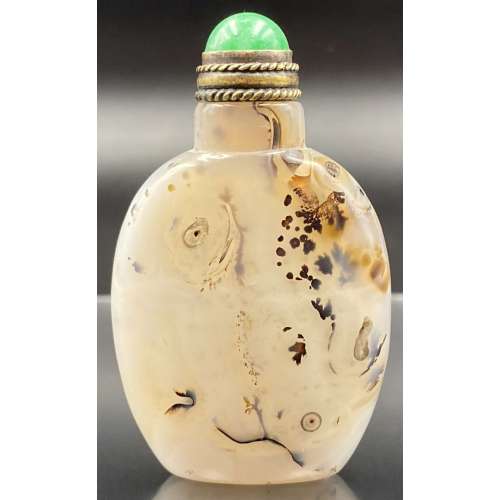 Agate snuff bottle of flattened rounded rectangular form, round neck, and flat base, semitransparent milky white body with dark brown inclusions of geometric form. Green jadeite stopper with a copper alloy spoon and collar. Qing dynasty [清] (1644-1912) Size: 7.2 x 4.3 x 2.2 cm
Agate snuff bottle of flattened rounded rectangular form, round neck, and flat base, semitransparent milky white body with dark brown inclusions of geometric form. Green jadeite stopper with a copper alloy spoon and collar. Qing dynasty [清] (1644-1912) Size: 7.2 x 4.3 x 2.2 cm -
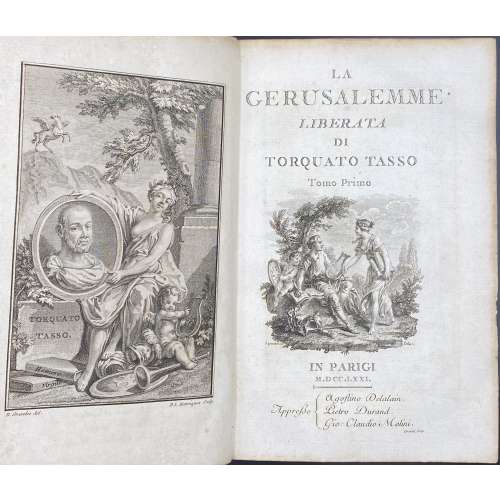 A two-volume set. Vol. 1:
A two-volume set. Vol. 1:Title: LA | GERUSALEMME | LIBERATA | DI | TORQUATO TASSO | Tomo Primo | {vignette} | IN PARIGI | M.DCC.LXXI | Appreßo { Agostino Delalain. | Pietro Durand. | Gio: Claudio Molini. | Droüet ∫crip.
Pagination: ffl [1] 2-331 [332] bfl; illustrations after Gravelot: frontis. by Henriquez, t.p. vignette by Patas, engraved dedication by Le Roy, 10 head- and 7 tailpieces by Le Roy, 5 full-page vignettes by Le Roy, and 10 plates by: Baquoy, Duclos (3), Le Roy, Lingée, Née, Rousseau, and Simonet (2).
Collation: 8vo; A-V8 X6.
Vol. 2: Title: LA | GERUSALEMME | LIBERATA | DI | TORQUATO TASSO | Tomo Secondo | {vignette} | IN PARIGI | M.DCC.LXXI | Appreßo { Agostino Delalain. | Pietro Durand. | Gio: Claudio Molini. | Droüet ∫crip. Pagination: ffl [1] 2-340 bfl; illustrations after Gravelot: frontis. by Henriquez, t.p. vignette by Mesnil, 10 head- and 6 tailpieces by Le Roy, 4 full-page vignettes by Le Roy, tailpiece by Ponce, and 10 plates by: Duclos, Henriquez, Leveau, Lingée, Massard, Née, Patas, Ponce, Rousseau, and Simonet. Collation: 8vo; A-X8 Y2. Size: 21.5 x 14.5 cm. Size of the copy sold at Sotheby's in 2015: 23.3 x 14.0 cm; Christie's in 2008: 23.2 x 14.4 cm Page size: 21 x 13.5 cm. In referenced sources, the page size is bigger than that. N. Ray gives 11 ½ x 8 7⁄8 inches or 9 x 5½ inches. Cohen and De Ricci do not bother to give sizes, considering that octavo is octavo. MFA: 30.3 x 23.1 x 4 cm (11 15/16 x 9 1/8 x 1 9/16 in.) Binding: Two volumes uniformly bound in full marbled calf, ruled in gilt, flat spine with gilt decorations and monogram, cream lettered label. Geoffrey Lord Cross of Chelsea [Geoffrey Cross, Baron Cross of Chelsea] (British, 1904 – 1989) bookplate to front pastedown. Catalogue raisonné: N. Ray №22, p. 48; Cohen De Ricci 974-975 According to MFA printing by: François-Augustin Quillau (French, 1743–1804). This edition was illustrated by Hubert François Gravelot (French, 1699–1773) and engraved by the following engravers: Jean Charles Baquoy (French, 1721–1777) Antoine Jean Duclos (French, 1742–1795) Benoît Louis Henriquez (French, 1732–1806) Jean Jacques André Le Veau (French, 1729–1785) Charles Louis Lingée (French, 1748–1819) Jacques Le Roy (French, born in 1739) Jean Massard (1740–1822) Elie du Mesnil (French, born about 1728) François Denis Née (French, 1735–1818) Charles Emmanuel Jean Baptiste Patas (French, 1744–1802) Nicholas Ponce (French, 1746–1831) Jean François Rousseau (French, born in 1740) Jean Baptiste Simonet (French, 1742–1813) Droüet (French, 18th century)


